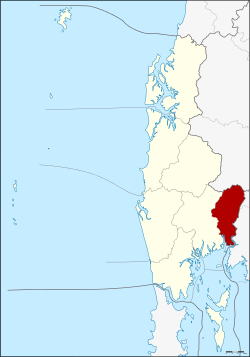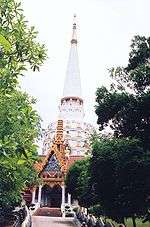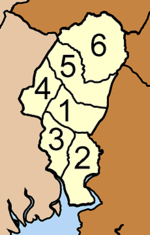Thap Put District
| Thap Phut ทับปุด | |
|---|---|
| Amphoe | |
 Amphoe location in Phang Nga Province | |
| Coordinates: 8°30′58″N 98°38′23″E / 8.51611°N 98.63972°ECoordinates: 8°30′58″N 98°38′23″E / 8.51611°N 98.63972°E | |
| Country |
|
| Province | Phang Nga |
| Seat | Thap Phut |
| Area | |
| • Total | 272.429 km2 (105.185 sq mi) |
| Population (2005) | |
| • Total | 24,046 |
| • Density | 88.3/km2 (229/sq mi) |
| Time zone | THA (UTC+7) |
| Postal code | 82180 |
| Geocode | 8207 |
Thap Phut (Thai: ทับปุด) is a district (amphoe) in the province Phang Nga in the south of Thailand.
History
In 1785 Burmese troops attacked Mueang Thalang. The inhabitants escaped from Thalang to the area of modern-day Thap Put. They built shelter that in southern Thai language are called Thap. The shelter were covered by tree leaves which are called Put.
The district was established in 1897 as one of the original districts of Phang Nga province.
Geography
Neighboring districts are (from the west clockwise) Mueang Phang Nga, Phanom of Surat Thani Province, Plai Phraya and Ao Luek and of Krabi Province. To the south is the Phang Nga Bay.
Attractions

Wat Rat Upatam (วัดราษฏร์อุปถัมภ์), commonly called Wat Bang Riang (วัดบางเหรียง) is a hill top temple. Within the bell-shaped chedi are various Buddha relics. Also a big statue of Kwam Im, the Chinese Goddess of Compassion, and a large Buddha statue on a pedestal surrounded by elephants belong to the temple. The hill allows a view till the Phang Nga Bay at clear weather.
Administration
The district is subdivided into 6 subdistricts (tambon), which are further subdivided into 38 villages (muban). Thap Phut itself has township (thesaban tambon) status. There are 5 Tambon administrative organization (TAO).
|
 |